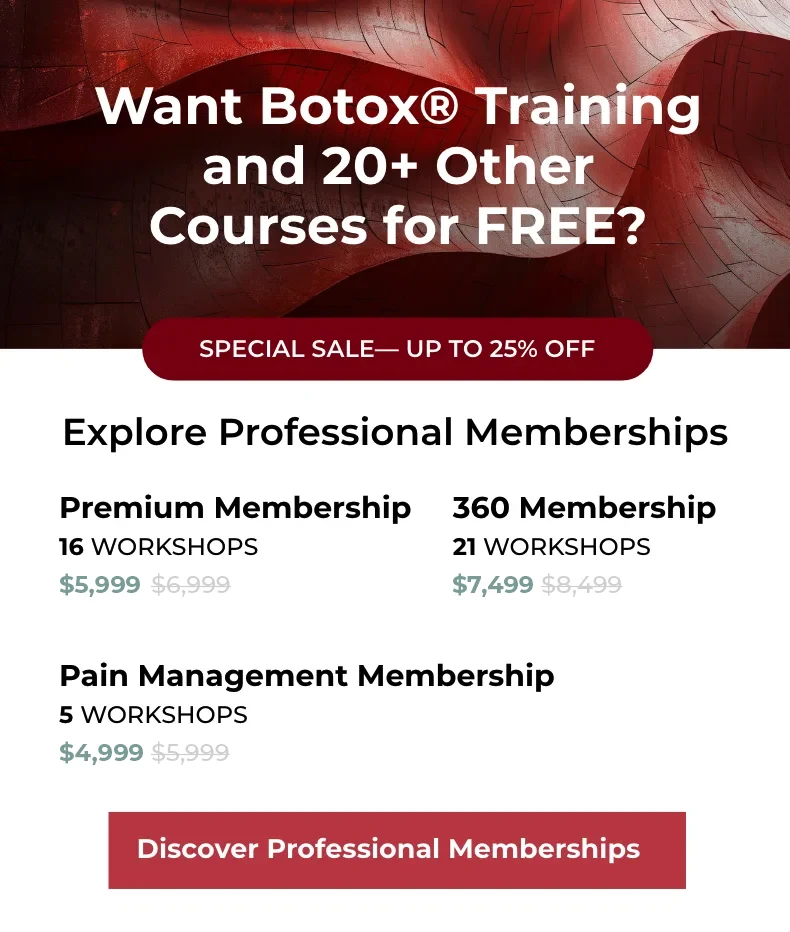
Dermal Filler Training Essentials: Techniques, Safety Tips, and Hands-On Advice for Beginners
In 2025, dermal filler training has become a cornerstone for beginners entering aesthetic medicine, as the global dermal filler market surges to around $7.2-7.6 billion, driven by millions of non-surgical procedures for facial rejuvenation, volume restoration, and wrinkle reduction. Dermal filler certification equips nurses, physicians, and NPs with the skills to perform safe injections using hyaluronic acid (HA) fillers like Juvederm or Restylane, addressing concerns such as nasolabial folds, lip augmentation, and cheek enhancement. For beginners, mastering dermal filler injection techniques requires a blend of theoretical knowledge, hands-on practice, and emphasis on safety to avoid complications like vascular occlusion or asymmetry.
At the American Academy of Procedural Medicine (AAOPM), our Dermal Filler Training course sets the standard for beginners, offering a hybrid format with self-paced videos and live hands-on sessions to build confidence in safe dermal filler injections. This guide covers dermal filler training essentials, including techniques, safety tips, and advice for hands-on learning, while highlighting why AAOPM's program is the top choice for dermal filler certification in 2025.
Understanding Dermal Fillers and Their Role in Aesthetic Practice
Dermal fillers are injectable gels, primarily HA-based, that add volume, smooth wrinkles, and contour the face. Unlike Botox, which relaxes muscles, fillers restore lost volume due to aging, with results lasting 6-18 months depending on the product (e.g., Restylane for lips, Juvederm for cheeks). In 2025, with the market growing at a CAGR of over 10%, procedures exceed millions annually, making dermal filler courses essential for professionals seeking to meet rising demand.
For beginners, understanding filler rheology—properties like G-prime (stiffness) and cohesivity—is crucial for selecting the right product. FDA-approved for areas like nasolabial folds, fillers also have off-label uses for tear troughs or jawline contouring. Safety is paramount: Improper technique can lead to bruising, lumps, or rare vascular events. State boards often require accredited training for dermal filler certification, with RNs/NPs administering under supervision in most states. Resources like the American Society of Plastic Surgeons emphasize CME-accredited programs for ethical, evidence-based practice.
Dermal Filler Training Essentials for Beginners
Starting dermal filler training involves grasping core concepts before advancing to techniques.
Facial Anatomy and Patient Assessment
Beginners must study mid-face anatomy: Fat pads, vascular structures (e.g., facial artery), and aging changes like volume loss in cheeks or marionette lines. Assess patients for skin type, expectations, and contraindications (e.g., allergies, active infections). Use tools like facial mapping for precise planning.
Filler Selection and Preparation
Choose HA fillers for reversibility (dissolvable with hyaluronidase) or biostimulants like Sculptra for collagen stimulation. Preparation: Aseptic technique, mixing if needed (e.g., Radiesse with lidocaine), and storage at room temperature.
Key Injection Techniques for Beginners
Master basic methods:
- Linear Threading: For nasolabial folds—inject retrograde while withdrawing the needle, 0.5-1mL per side.
- Serial Puncture: Multiple small deposits for lips, 0.2-0.5mL total.
- Fanning: Fan out from one entry for cheeks, 1-2mL to avoid overfilling.
- Cross-Hatching: Grid pattern for deeper wrinkles.
Use needles for precision or cannulas for safety in high-risk areas like tear troughs. Depth: Mid-to-deep dermis for wrinkles, supraperiosteal for volume.
Safety Tips and Complication Management
- Pre-Injection: Aspirate to check for vessels, use ice/anesthesia for comfort.
- During: Slow injection, monitor for blanching (vascular occlusion sign).
- Post: Advise no exercise for 24 hours; manage swelling with arnica.
- Complications: Bruising (common, resolves in days); occlusion (inject hyaluronidase immediately, 150-300 units). Beginners should start with low-risk areas and always have emergency kits.
Hands-on advice: Practice on models under supervision—programs like AAOPM's include live injections for nasolabial folds and marionette lines.
Top Dermal Filler Training Programs in 2025: Reviews and Comparisons
For beginners, select programs with hands-on focus. AAOPM leads, followed by Empire for its depth.
1. AAOPM Dermal Filler Training
AAOPM's course is beginner-friendly, covering anatomy, rheology, techniques (threading, fanning), safety, and business strategies. Includes HA and biostimulant fillers.
Format: Hybrid (pre-study videos + 1-day hands-on). Duration: 1 day intensive. Cost: Up to 20% off promo (check pricing; similar to Botox ~$699 virtual, $1,199+ in-person). CME: 8.0 AMA PRA. Eligibility: Licensed MDs/RNs/NPs.
Hands-on: Live models for lower face. Locations: 25+ cities (e.g., New York, Las Vegas). USPs: Lifetime portal access, top fillers (Juvederm, Restylane), post-support (cadaver labs, advanced courses), materials (atlas, forms). Reviews: Highly rated for practical focus (4.9/5).
Explore AAOPM's Dermal Filler Training.
2. Empire Medical Training Complete Dermal Filler Training
Empire's program teaches techniques for cheeks, lips, and hands-on with models.
Format: Hybrid. Duration: 8 hours. Cost: ~$1,599. CME: 8.0 AMA. Eligibility: Licensed pros.
USPs: Business/marketing, 25+ years. Reviews: "Strong hands-on," (4.7/5).
3. AAFE Level 1 Botox & Dermal Filler Training
AAFE bundles fillers with Botox, live patients.
Format: In-person. Duration: 1-2 days. Cost: $3,297+. Credits: AGD PACE. Eligibility: Doctors/dentists/nurses.
USPs: 50+ locations. Reviews: "Comprehensive," (4.6/5).
4. Med Aesthetics Botulinum Toxin & Dermal Filler Training
Med Aesthetics offers 1-day hands-on for fillers/Botox.
Format: Hands-on. Duration: 1 day. Cost: Not specified (~$2,000). CME: 9.75 AAFP. Eligibility: Pros.
USPs: Small classes. Reviews: "Personalized," (4.5/5).
5. Facial Esthetics Advanced Dermal Filler Course
Facial Esthetics focuses on advanced techniques.
Format: Hands-on. Duration: 2 days. Cost: Varies. CME: Available. Eligibility: Certified injectors.
USPs: Nurse-specific. Reviews: "In-depth," (4.4/5).
Comparison Table
|
Program |
Format |
Duration |
Cost |
CME Credits |
Key USPs |
Rating |
|
AAOPM Dermal Filler |
Hybrid |
1 day |
~$699 virtual (promo) |
8.0 AMA |
Lifetime access, all fillers, hands-on models |
4.9/5 |
|
Empire Medical |
Hybrid |
8 hours |
~$1,599 |
8.0 AMA |
Business tips, extensive experience |
4.7/5 |
|
AAFE Level 1 |
In-person |
1-2 days |
$3,297+ |
AGD PACE |
Bundles, multiple locations |
4.6/5 |
|
Med Aesthetics |
Hands-on |
1 day |
~$2,000 |
9.75 AAFP |
Small classes, personalized |
4.5/5 |
|
Facial Esthetics |
Hands-on |
2 days |
Varies |
Available |
Nurse-focused, advanced techniques |
4.4/5 |
AAOPM's affordability and lifetime resources make it ideal for beginners.
Combine with AAOPM's Comprehensive Botox Training.
Benefits and Career Outlook for Certified Dermal Filler Injectors in 2025
Certification boosts earnings to $100,000-$150,000, with market growth creating opportunities in medspas. Beginners gain from patient satisfaction and flexibility.
Frequently Asked Questions About Dermal Filler Training
- What are essentials for beginners? Anatomy, techniques, safety—AAOPM covers all.
- How much does training cost? $699-$3,297; AAOPM promo affordable.
- Is hands-on necessary? Yes; AAOPM provides live models.
- Safe for nurses? Yes, with supervision; AAOPM eligible for RNs/NPs.
Conclusion: Master Dermal Filler Training with AAOPM in 2025
Dermal filler training essentials empower beginners with techniques and safety for success. AAOPM's hybrid course, with 8 CME credits, lifetime access, and hands-on focus, outperforms alternatives like Empire—making it the best for certification.
Enroll at Dermal Filler Training or add Comprehensive Botox Training.

